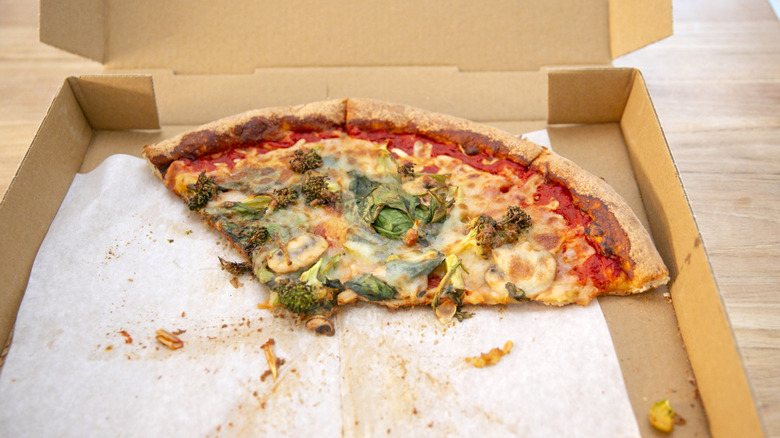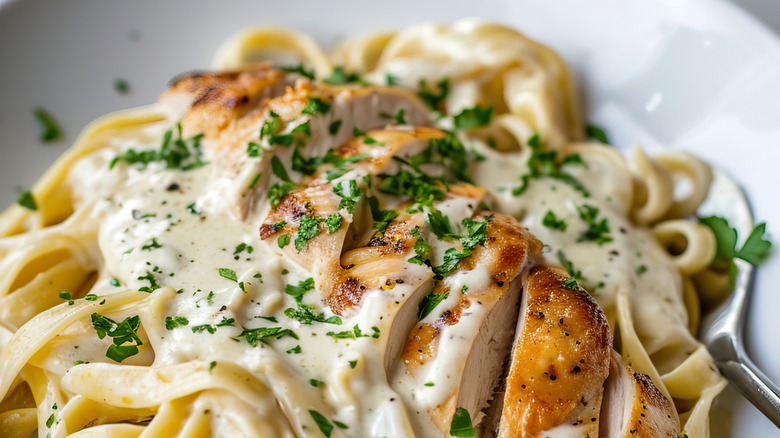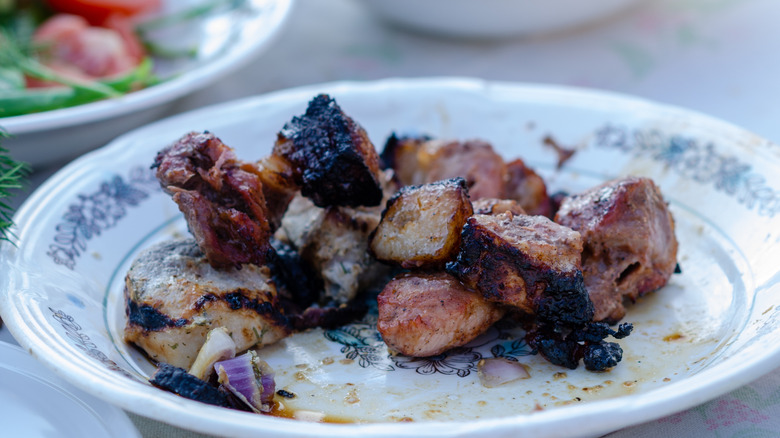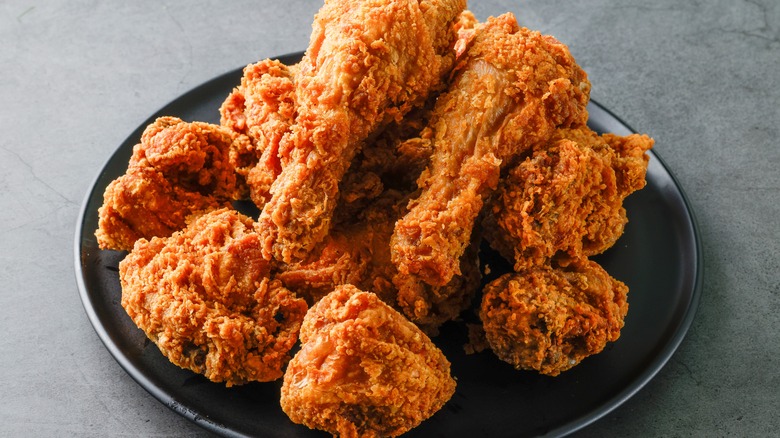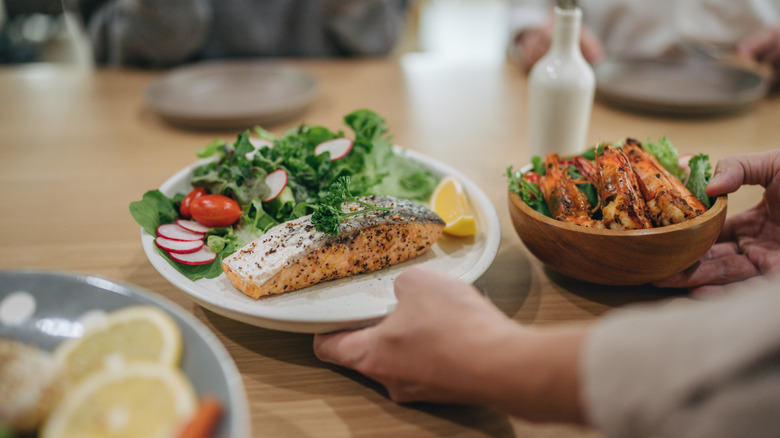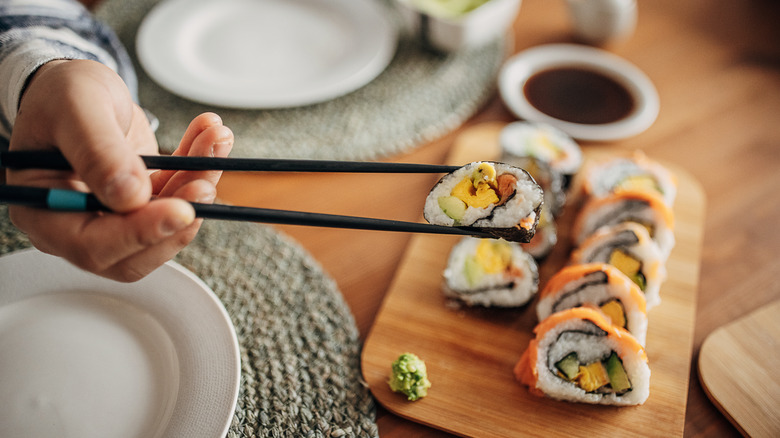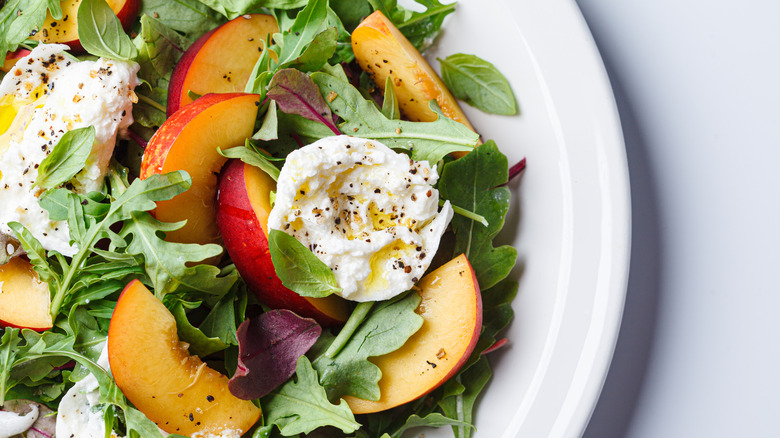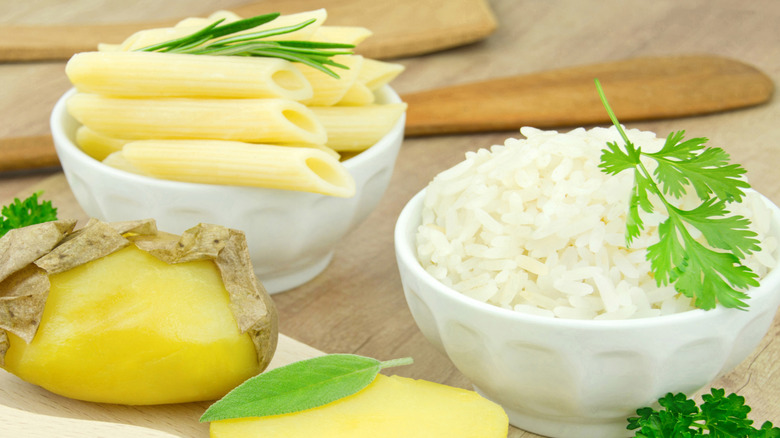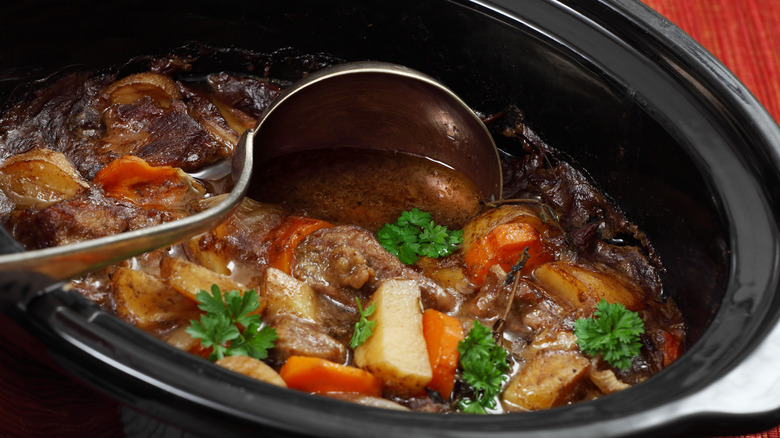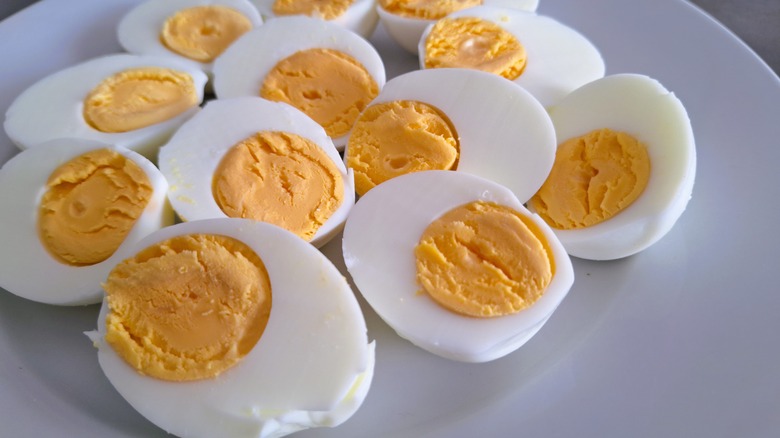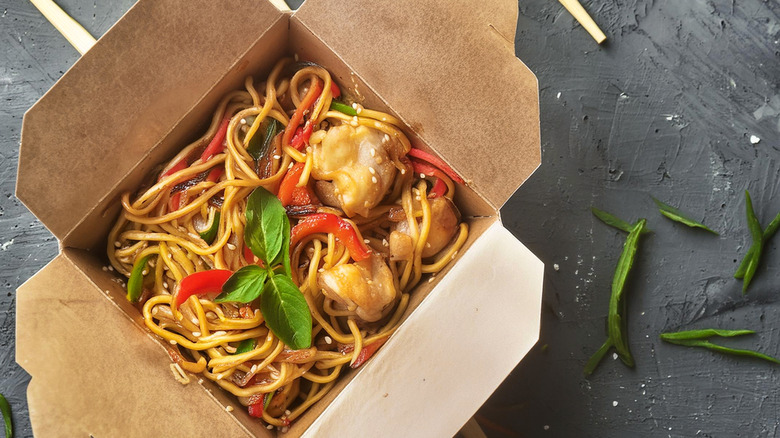12 Leftovers And How Long You Have Until You Need To Throw Them Out
As food prices soar, saving your leftovers makes great cents — and sense. It also comes in handy during busy work weeks, or when you need a quick dinner for one and don't feel like cooking. But while most types of leftovers can be enjoyed within a few days, there are some precautions you need to take to avoid regretting saving a few bucks. Even the hardiest, most shelf-stable foods will eventually go bad if not eaten soon enough, or if you fail to put your leftovers in the fridge within a certain amount of time.
According to the United States Department of Agriculture (USDA), food must be cooked to a safe temperature and then refrigerated properly if not eaten soon after preparation. The longer leftovers sit in the temperature danger zone of 40 and 140 degrees Fahrenheit, the more susceptible they are to bacterial growth that can cause foodborne illness. The USDA recommends cooling leftovers quickly, even if you have to divide large quantities into smaller containers. Not portioning out your food before cooling it may be one of the 14 mistakes you're making with leftover food. Always seal your leftovers in an airtight container or tightly wrapped foil to help them retain moisture and keep out bacteria. Just how long you can keep these leftovers depends on the food in question. Here is how long you can safely store popular food items before it's time to toss them into the trash.
Dairy-based food
If you can't finish a decadent plate of fettuccine Alfredo or made too much creamy broccoli and cheddar soup for last night's dinner, pop them in the refrigerator to enjoy as a treat at a later time. Although leftover dairy-based food typically only lasts a few days, even when properly stored, the good news is that you'll have no problem recognizing the smell of a good thing gone bad. If you're not consuming them, dairy products need to stay cold at all times. The recommended temperature range is between 32 and 38 degrees Fahrenheit. This is because dairy-based food items expire at a rate that becomes 50% faster for every 5 degrees over 38 degrees Fahrenheit.
Ideally, leftover dairy items such as cream sauces, soups, and gravies must be refrigerated as soon as possible after being cooked at home or served at a restaurant. When properly packaged and stored, the leftovers will last for between three and four days in a refrigerator, and up to six months in a freezer, depending on the item in question. Wrap or package your leftovers in a moisture-resistant container before placing them into the freezer, and store at 0 degrees Fahrenheit or below. If your creamy leftovers are still hot, cool them in your refrigerator rather than on a countertop.
Meat
Even though different types of meat require various internal temperatures before being safely consumed, they generally have the same recommended leftover shelf life. As a general rule, most meat leftovers — including steak, hamburgers, ground beef, pork chops, and lamb — can be refrigerated for three to four days. Deli meats may last slightly longer. After that amount of time, dangerous bacteria can start to grow and quickly multiply, even if the meat is kept out of the danger zone temperature. Although you can typically smell when meat is rancid, that's not always the case, and you can't always rely on a quick sniff test.
Fully cooked meat leftovers can be frozen for two to six months when properly stored. Soups and stews with meat added will stay safe in a freezer for between two and three months. When it's time to eat your meaty leftovers, the USDA recommends reheating them in an oven set no lower than 325 degrees Fahrenheit to discourage bacterial growth. The internal temperature of the leftover meat should reach a minimum of 165 degrees Fahrenheit.
Poultry
There's nothing like getting a platter of crispy fried chicken from your favorite eatery or ordering takeout wings to enjoy along with your pizza. If your eyes were bigger than your stomach, put the poultry in your refrigerator within an hour or two, and enjoy it again within three to four days. No matter what type of chicken leftovers you have — including patties and nuggets, drumsticks or thighs, or even salad — they'll be safe in your refrigerator for the same standard amount of time. Fully cooked chicken sausage and deli meat can be refrigerated for up to one week, as they contain higher sodium levels. The poultry must have been cooked to the USDA recommended temperature of 165 degrees Fahrenheit. The leftovers also need to be reheated to that temperature to prevent foodborne illness.
Properly cooked and stored chicken leftovers can be safely frozen for two to six months. The exception to this rule is chicken nuggets and patties, which have a maximum freeze time of between one and three months. Whether you store your leftover chicken in a refrigerator or freezer, always label the container with the contents and date to be on the safe side.
Fish and shellfish
Full of high-quality protein and a variety of essential vitamins and minerals, seafood is as good for you as it is tasty. When fish and shellfish — including oysters, crab, and shrimp — are raw, you can often tell if they have gone bad with just one whiff. After it's cooked, however, it may be a bit more difficult to detect, especially if it's been marinated in a spicy sauce or breaded.
After purchasing fresh seafood or thawing it in the refrigerator, it's best to use it within two days to avoid foodborne illness, such as salmonella. Ideally, cooked fish and shellfish must reach an internal temperature of 145 degrees Fahrenheit. The flesh of most seafood will turn white and opaque when it's thoroughly cooked.
If you went out to eat and couldn't finish your fried shrimp, or you made too much grilled salmon at home, it's important to put the leftovers in the refrigerator right away. All prepared fish and seafood must cool to a temperature of 41 degrees Fahrenheit or below within two hours of cooking to prevent bacterial growth. After that, it can be safely stored in the refrigerator for three to four days or frozen for up to three months.
Sushi
Everyone knows that sushi tastes best right when it's freshly prepared and served alongside ginger and soy sauce, but if you can't eat all of your spicy salmon or shrimp tempura roll, don't throw it away. Although it won't last as long as other types of leftovers, you can still enjoy sushi for lunch or even dinner the next day.
While sushi containing both raw and cooked fish and shellfish should not be kept at room temperature longer than two hours, they have different refrigerator storage times. Sushi made with raw seafood can be stored in the refrigerator for one to two days, while its cooked counterpart can chill for three to four days. Who can resist sushi for longer than that, anyway?
Although sushi is still safe to consume after being in the refrigerator, its texture and taste may be compromised after an extended period. The same is especially true if you decide to freeze sushi for later. The rice may become hard, while the texture of the fish and seafood may start to get chewy. Prior to storing the leftovers, wrap them tightly in plastic wrap, foil, or an airtight container for the best results. Also, store the raw and cooked sushi separately to avoid cross-contamination.
Pizza
Ah, leftover pizza. It's the breakfast of champions — or a fast and easy lunch, or dinner the next day. Memories of boxes of cold pizza lying around college dorms may make you think that the pies are perfectly safe to store outside the refrigerator, but that's sadly not true. It's actually only safe to keep pizza at room temperature for approximately two hours, and even less time if it's outside in the heat. This is true even if your leftover pizza contains just cheese and veggies, as even non-meat ingredients are susceptible to bacterial growth. Eating pizza that has been left outside the refrigerator for too long can put you at risk for foodborne illnesses such as salmonellosis and staphylococcus aureus infections.
If you haven't lost your appetite by now, feel free to eat your refrigerated leftover pizza within three to four days. If you want to freeze a slice or two, you can do so for one to two months. In both cases, be sure to wrap the pizza slices tightly in plastic or foil, or place them in a resealable storage bag. You can keep your leftover pie in its cardboard box, but it may dry out when exposed to the cold air. When it comes time to eat your leftovers, you may want to consider reheating your extra pizza slices on a griddle for perfectly melted cheese and an extra crispy crust.
Salads
Although you can save your leftover salad to eat at a later time, it's a bit trickier than dealing with other types of uneaten food. While you may have stashed away the salad you made for dinner to enjoy as a light lunch the next day, one look at its sad, wilted greens and less-than-crunchy croutons may have you tempted to order takeout instead. The good news is that there is a way to keep your salad fresh and vibrant when stored in the refrigerator. If you're making a salad and know you want to save some for the next day, only apply dressing to the portion you're consuming right away to avoid a soggy mess later on. If the leftover lettuce and other delicate vegetables are swimming in oil and vinegar, they may not be salvageable.
You can separate the various components of the salad, such as whole cherry tomatoes and green pepper rings, and store them individually in the refrigerator. Placing paper towels between layers of lettuce may also help keep it dry by absorbing excess moisture. It's also ideal to avoid storing your salad in the back of the refrigerator, where it tends to be colder, as the lettuce and other vegetables may freeze. If they don't get too soggy, salad leftovers will safely last three to four days in the refrigerator.
Pasta and rice
You may not think that properly storing leftover rice and pasta is as critical as meat and seafood, but the two carbohydrates can also be breeding grounds for bacteria. Both uncooked rice and pasta may contain bacterial spores that can survive on the starches even after they're properly cooked, then quickly multiply if left out at room temperature for longer than two hours.
For safety purposes, be sure to cool both prepared rice and pasta quickly, place them in airtight storage containers, and then store them in the refrigerator for between three and four days. If your cooked carbohydrates stay in the USDA's temperature danger zone for too long, bacteria levels can double every 20 minutes.
When you reheat pasta or rice, ensure that they both reach a temperature of 165 degrees Fahrenheit and enjoy them right away. Don't store and reheat them more than once for both food safety and taste reasons. If you're looking for a delicious way to reuse your leftover rice, you can always use it to make the perfect fried rice.
Soup and stew
Making big batches of soup or stew is the ideal way to save both time and money, especially in the cold fall and winter months. They're both easy to whip up using simple pantry ingredients and any vegetables that are on the brink of going bad and need to be consumed sooner rather than later. If you're making the soup or stew in a slow cooker or a big pot on the stove, it's best to cool the leftovers down quickly and place them in the refrigerator within two hours, rather than letting them sit on a warm setting for too long. Not only will doing so continue to cook your food past the recommended length of time, but it can also put your tasty stew or soup at risk for bacterial growth. The maximum recommended time for keeping your food on a slow cooker's warm setting is no longer than four hours.
After the soup or stew leftovers are cooled and placed into airtight containers, they can stay in the refrigerator for three to four days. If you plan on freezing the meals, scrape any fat off the top before placing them into the freezer. You can safely freeze soup or stew for two to three months, whether it contains vegetables or meat.
Hard-boiled eggs
Making a big batch of hard-boiled eggs on Sunday to use in salads and as snacks all week is a smart idea. After they're cooked, the USDA recommends placing the eggs in the refrigerator within two hours. Once properly stored, you can keep both peeled and unpeeled hard-boiled eggs in the refrigerator for up to seven days. If you use some of the cooked eggs to make a creamy, mayonnaise-based egg salad, store it in an airtight container in the refrigerator for up to five days. Freezing hard-boiled eggs generally isn't recommended due to the impact on texture. Similarly, freezing egg salad may change its consistency.
Before storing your hard-cooked eggs in the refrigerator, give them a cold water or ice bath to bring their temperature down quickly. You can place both peeled and unpeeled hard-boiled eggs in a resealable plastic bag or an airtight storage container before putting them into the refrigerator. Place the eggs on the middle shelf, where the appliance's temperature is more stable, until you eat them.
Takeout food
When you're placing a takeout order while hungry, it's easy to buy too much food. That's not necessarily a bad thing, since the leftovers can make a handy and delicious midnight snack or lunch the following day. Like most other types of leftovers, takeout food shouldn't be left out for more than two hours, or one hour if the temperature is 90 degrees Fahrenheit or higher. This means that if you plan on seeing a movie after going out to dinner, it's best not to take your leftovers along for the ride. The USDA recommends discarding any food — including casseroles, poultry, meat, seafood, and side dishes — that has lingered outside the refrigerator for too long.
Before putting your takeout food in the refrigerator, take it out of its to-go box or bag, and place it into an airtight container or resealable storage bag marked with the date. The food will last for three to four days when stored properly in your fridge. If it contains meat, it can last up to six months in the freezer. If frozen for longer, it may decline in quality of flavor and texture. If you don't plan on eating all your leftover takeout at once, heat the portion you want to consume to 165 degrees Fahrenheit, then put the rest back into the refrigerator right away.
Desserts
If you're lucky enough to have leftover dessert, you can store it in either your refrigerator or freezer to enjoy another day. Although some desserts, such as cookies and unfrosted cakes, taste better stored in an airtight container at room temperature, refrigeration is recommended if you're not going to consume the sweet treats within about three days. Desserts containing perishable elements, such as whipped cream or fresh fruit, should be refrigerated as soon as possible.
In general, frosted and unfrosted cakes, as well as cheesecakes, will last approximately a week in the refrigerator, while fruit pies should be consumed or frozen within four days. When properly stored, cookies will last about two weeks in the refrigerator. Most baked goods can be frozen for around three months before the taste and texture are compromised.
When storing leftover desserts, the right storage containers are the key to freshness. If you plan on refrigerating baked goods, transfer them into airtight plastic or glass storage containers so they don't dry out. Before putting desserts into the freezer, place them in resealable plastic storage bags marked with the contents and date.
